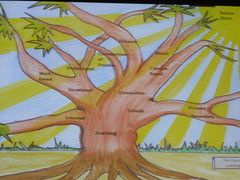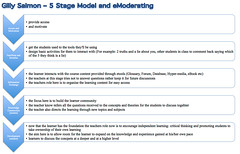 Image by mikecogh via Flickr
Image by mikecogh via FlickrGilly Salmon was the first keynote of ASCILITE 2011, and her presentation was accompanied by a visual representation of the presentation as it was underway. She started by talking about her professional 'journey' around the topic of forge (to form or make through concentrated effort...). Gilly used to work for the Open University in the UK and even though the OU was ostensibly 'distance learning' there was quite a few face-to-face tutorials. This became a problem once they opened up programmes in Europe where students were geographically disparate and there was no way that they could drive into, say, Paris on a weekly basis for tutorials. This sparked some creative thinking around hwo to connect and communicate (prior to, for example, graphic user interfaces).
 Image via Wikipedia
Image via WikipediaSome of the things that Gilly learned on the way 1) if you want the future of learning to work you have to design it; 2) the actual role of facilitation is different to the design process; 3) if you want to know if it's working - ask your students!!
Between 1992 and 1995 Gilly developed a five stage model for productive learning forms around 1) access and motivation, 2 culture building, 3 co-operation, 4 collaboration, 5) development. Once students have forged relationships they are more likely to help each other, and there needs to be motivation to come back again and again...this in particular is to see of there is a message in response to something they have posted. This means someone needs to have posted a response, and the facilitator will need to build this culture. Little easy things should build toward a final larger task. The steps break into roles welcome, host, lead, facilitate and guide. The welcome should be around welcoming a person, and congratulated for coming back, leading is showing how being part of the environment and contributing to it will be of value to them.
 Image by vickel_n via Flickr
Image by vickel_n via FlickrGilly broke down the eModerating roles as follows. She advised that you need to recruit people who are more comfortable as guides on the side, and who do not see elearning as a substitute for something better. She emphasised that it is important to train everyone beforehand before letting them loose in the online environment. It's also good if they have had experience of being an eLearning, and who have a 'reflective edge'. The training aspect needs to have aspects of 'weaving and summarising', as well as diversity - although this tends to come with experience rather than being something that you can train people to 'do'.
The five stage model becams a catalyst for many people who started using it to design learning experiences for students. This in turn impacted Gilly who herself started to design programmes in quite a different way.
 Image via Wikipedia
Image via WikipediaYou can't design programmes on your own any more. This is something that Gilly has called Designing together: Carpe Diem which is a model for learing design that uses the five stage model as a foundation, and has since been developed further. The idea was that the session was run over a day, but it actually needs a couple of days. The first day focuses on the design, and the second on the build. Story boarding is a fundamental aspect of the process.
Gilly concluded that your own 'forge' needs to be grounded and practical, driven by needs and a purpose, addresses prior design and deliverly, and is adaptable and flexible.
While there was nothing new in the presentation, it was a superb overview of the development of eLearning and associated design and facilitation considerations...and the importance aspects of how to make 'virtual' learning effective.






No comments:
Post a Comment